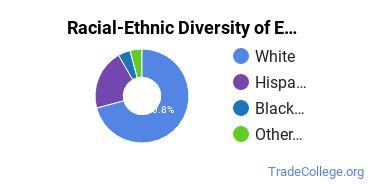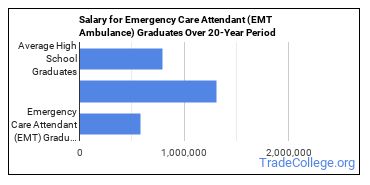Emergency Care Attendant (EMT)
Featured schools near , edit
Types of Degrees Emergency Care Attendant (EMT) Majors Are Getting
The following table lists how many emergency care attendant (emt ambulance) graduations there were in 2021-2022 for each degree level.
| Education Level | Number of Grads |
|---|---|
| Basic Certificate | 3,284 |
| Undergraduate Certificate | 71 |
| Associate Degree | 18 |
What Emergency Care Attendant (EMT) Majors Need to Know
In an O*NET survey, emergency care attendant (emt ambulance) majors were asked to rate what knowledge areas, skills, and abilities were important in their occupations. These answers were weighted on a scale of 1 to 5 with 5 being the most important.
Knowledge Areas for Emergency Care Attendant (EMT Ambulance) Majors
Emergency Care Attendant (Emt Ambulance) majors often go into careers in which the following knowledge areas are important:

- English Language - Knowledge of the structure and content of the English language including the meaning and spelling of words, rules of composition, and grammar.
- Customer and Personal Service - Knowledge of principles and processes for providing customer and personal services. This includes customer needs assessment, meeting quality standards for services, and evaluation of customer satisfaction.
- Public Safety and Security - Knowledge of relevant equipment, policies, procedures, and strategies to promote effective local, state, or national security operations for the protection of people, data, property, and institutions.
- Administration and Management - Knowledge of business and management principles involved in strategic planning, resource allocation, human resources modeling, leadership technique, production methods, and coordination of people and resources.
- Law and Government - Knowledge of laws, legal codes, court procedures, precedents, government regulations, executive orders, agency rules, and the democratic political process.
Skills for Emergency Care Attendant (EMT Ambulance) Majors
A major in emergency care attendant (emt ambulance) prepares you for careers in which the following skill-sets are crucial:

- Critical Thinking - Using logic and reasoning to identify the strengths and weaknesses of alternative solutions, conclusions or approaches to problems.
- Service Orientation - Actively looking for ways to help people.
- Active Listening - Giving full attention to what other people are saying, taking time to understand the points being made, asking questions as appropriate, and not interrupting at inappropriate times.
- Reading Comprehension - Understanding written sentences and paragraphs in work related documents.
- Speaking - Talking to others to convey information effectively.
Abilities for Emergency Care Attendant (EMT Ambulance) Majors
As a emergency care attendant (emt ambulance) major, you will find yourself needing the following abilities:

- Oral Comprehension - The ability to listen to and understand information and ideas presented through spoken words and sentences.
- Problem Sensitivity - The ability to tell when something is wrong or is likely to go wrong. It does not involve solving the problem, only recognizing there is a problem.
- Oral Expression - The ability to communicate information and ideas in speaking so others will understand.
- Deductive Reasoning - The ability to apply general rules to specific problems to produce answers that make sense.
- Near Vision - The ability to see details at close range (within a few feet of the observer).
What Can You Do With a Emergency Care Attendant (EMT) Major?
People with a emergency care attendant (emt ambulance) degree often go into the following careers:
| Job Title | Job Growth Rate | Median Salary |
|---|---|---|
| Ambulance Drivers and Attendants, Except Emergency Medical Technicians | 22.0% | $25,750 |
Who Is Getting an Associate’s Degree in Emergency Care Attendant (EMT)?
Racial-Ethnic Diversity
At the countrywide level, the racial-ethnic distribution of emergency care attendant (emt ambulance) majors is as follows:

| Race/Ethnicity | Number of Grads |
|---|---|
| Asian | 0 |
| Black or African American | 1 |
| Hispanic or Latino | 8 |
| White | 7 |
| International Students | 1 |
| Other Races/Ethnicities | 1 |
Geographic Diversity
Students from other countries are interested in Emergency Care Attendant (EMT Ambulance), too. About 5.6% of those with this major are international students.
How Much Do Emergency Care Attendant (EMT) Majors Make?
Salaries According to BLS
Emergency Care Attendant (Emt Ambulance) majors often go into careers with median salaries of $29,010. This median refers to all degree levels, so you may expect those with a more advanced degree to make more while those with less advanced degrees will typically make less.
To put that into context, according to BLS data from the first quarter of 2020, the typical high school graduate makes between $30,000 and $57,900 a year (25th through 75th percentile). The average person with a bachelor’s degree (any field) makes between $45,600 and $99,000. Advanced degree holders make the most with salaries between $55,600 and $125,400.
Amount of Education Required for Careers Related to Emergency Care Attendant (EMT)
Some degrees associated with emergency care attendant (emt ambulance) may require an advanced degree, while others may not even require a bachelor’s in the field. In general, the more advanced your degree the more career options will open up to you. However, there is significant time and money that needs to be invested into your education so weigh the pros and cons.
Find out what the typical degree level is for emergency care attendant (emt ambulance) careers below.

| Education Level | Percentage of Workers |
|---|---|
| Less than a High School Diploma | 1.0% |
| High School Diploma - or the equivalent (for example, GED) | 56.3% |
| Post-Secondary Certificate - awarded for training completed after high school (for example, in agriculture or natural resources, computer services, personal or culinary services, engineering technologies, healthcare, construction trades, mechanic and repair technologies, or precision production) | 19.6% |
| Some College Courses | 23.1% |
Online Emergency Care Attendant (EMT) Programs
The following table lists the number of programs by degree level, along with how many schools offered online courses in the field.
| Degree Level | Colleges Offering Programs | Colleges Offering Online Classes |
|---|---|---|
| Certificate (Less Than 1 Year) | 0 | 0 |
| Certificate (1-2 years) | 13 | 0 |
| Certificate (2-4 Years) | 0 | 0 |
| Associate’s Degree | 10 | 0 |
| Bachelor’s Degree | 0 | 0 |
| Post-Baccalaureate | 0 | 0 |
| Master’s Degree | 0 | 0 |
| Post-Master’s | 0 | 0 |
| Doctor’s Degree (Research) | 0 | 0 |
| Doctor’s Degree (Professional Practice) | 0 | 0 |
| Doctor’s Degree (Other) | 0 | 0 |
Is a Degree in Emergency Care Attendant (EMT) Worth It?
The median salary for a emergency care attendant (emt ambulance) grad is $29,010 per year. This is based on the weighted average of the most common careers associated with the major.

Explore Major by State
Alabama
California
District of Columbia
Idaho
Kansas
Maryland
Mississippi
Nevada
New York
Oklahoma
South Carolina
Utah
West Virginia
Alaska
Colorado
Florida
Illinois
Kentucky
Massachusetts
Missouri
New Hampshire
North Carolina
Oregon
South Dakota
Vermont
Wisconsin
Trades Related to Emergency Care Attendant (EMT)
You may also be interested in one of the following majors related to emergency care attendant (emt ambulance).
References
*The racial-ethnic minorities count is calculated by taking the total number of students and subtracting white students, international students, and students whose race/ethnicity was unknown. This number is then divided by the total number of students at the school to obtain the racial-ethnic minorities percentage.
- College Factual
- College Scorecard
- National Center for Education Statistics
- O*NET Online
- U.S. Bureau of Labor Statistics
- Usual Weekly Earnings of Wage and Salary Workers First Quarter 2020
More about our data sources and methodologies.
Featured Schools
 Request Info
Request Info
|
Southern New Hampshire University You have goals. Southern New Hampshire University can help you get there. Whether you need a bachelor's degree to get into a career or want a master's degree to move up in your current career, SNHU has an online program for you. Find your degree from over 200 online programs. Learn More > |
